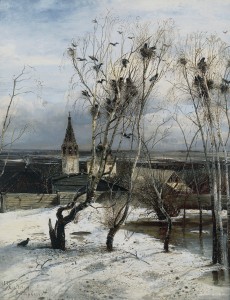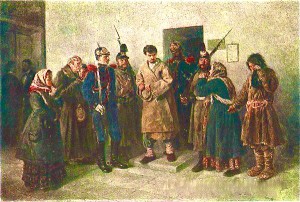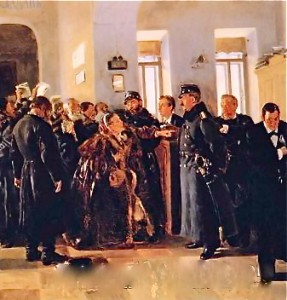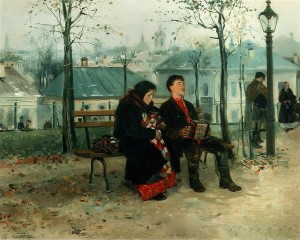“I am a devil. I work as a special envoy under the leadership of…Satan. I am not employed at the moment, [but] I did have a job some time ago. We were tempting people, seducing them from the path of goodness. Between us, this occupation is not worth a penny. There is no path of good—it does not exist anymore among humans, and so there is nothing to seduce people away from….How can I teach someone how to steal a penny if he, without my help, has already stolen thousands, or even millions?”
In this qu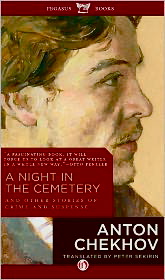 otation from “Conversation of a Drunken Man with a Sober Devil,” one of the forty-two stories included in A Night in the Cemetery and Other Stories of Crime and Suspense by Anton Chekhov, the author expresses both his ironic humor and his dark assessment of humanity, characteristics which epitomize this entire collection. Though he is better known now for his playwriting skills, Chekhov was a prodigious writer of stories from 1880, when he was a twenty-year-old medical student, until 1890, and it was these stories that kept his family fed and clothed for most of that decade. By 1884, Chekhov, still writing stories, was a practicing physician traveling the countryside and not charging the poor for his services, and much of the social breadth we see in his stories has come about as a direct result of this close contact with all levels of society. The conflicts in his stories, sharply realized, show the chasm between rich and poor, and educated and uneducated, and Chekhov, almost without exception, depicts the poor and uneducated as having more integrity, being less tempted by “the devil.”
otation from “Conversation of a Drunken Man with a Sober Devil,” one of the forty-two stories included in A Night in the Cemetery and Other Stories of Crime and Suspense by Anton Chekhov, the author expresses both his ironic humor and his dark assessment of humanity, characteristics which epitomize this entire collection. Though he is better known now for his playwriting skills, Chekhov was a prodigious writer of stories from 1880, when he was a twenty-year-old medical student, until 1890, and it was these stories that kept his family fed and clothed for most of that decade. By 1884, Chekhov, still writing stories, was a practicing physician traveling the countryside and not charging the poor for his services, and much of the social breadth we see in his stories has come about as a direct result of this close contact with all levels of society. The conflicts in his stories, sharply realized, show the chasm between rich and poor, and educated and uneducated, and Chekhov, almost without exception, depicts the poor and uneducated as having more integrity, being less tempted by “the devil.”

Though Chekhov’s story collection, At Dusk, won the Pushkin Prize in 1887 for “the best literary production distinguished by high artistic worth,” many more of his earlier stories remained “uncollected.” Those in this collection, published in 2008, are, for the most part, stories by a very young medical student in his twenties, someone who is often angry, even a bit cynical, about the inherent willingness of mankind to yield to temptation without even a qualm. There are no saints in these stories, only sinners to a greater or lesser degree. Though the stories often lack the subtlety and narrative brilliance of his later writing, especially his more highly developed plays, the youthful Chekhov keeps his stories lively and fresh through his darkly humorous take on life’s ironies, often turning conflicts into tours de force in the conclusions. The reader is constantly surprised by stories in which a predictable ending is turned on its head.
In the opening story, “A Night in the Cemetery,” a man is telling a story about his New Year’s Eve celebration. He was extremely drunk (a condition of a great many characters throughout these stories) but defends his condition because he believes “it is a worthy pursuit for people to feel happy on New Year’s Eve. Every coming year is as bad as the previous one, the only difference being that in most cases it is even worse.” He thinks people “should fight, be miserable, cry, and attempt suicide. One must remember that each new year leads you closer to death.” When he finds himself in a cemetery, he believes he hears a “dead man walking.” This story sets the tone for the collection, with its strong emphasis on death, its irony, its “surprise” ending (which, I hate to say, is one that only beginning writers would come up with), its narrative speed, its lack of characterization, and its literary naivete.
That “naivete,” however, is counterbalanced by the next “story,” a three-hundred word piece entitled “What You Usually Find in Novels.” Here Chekhov lists all the clichés of the novels of the period, including heroes who save a heroines from crazed horses, sympathetic servants, broad vistas, friends who are blond (enemies are red-headed), doctors with walking sticks, and loyal dogs. Ultimately, “What You Find in Novels” are “Seven mortal sins at the beginning, a crime in the middle, and a wedding at the end.” The cliches he does not discuss, and which seems to characterize his own stories here, are that nearly all take place at night and all take place in winter.
“The Swedish Match,” at twenty-seven pages, the longest story by far (with most of the others varying from three pages to ten), is similar to the Sherlock Holmes stories, with the roles of Holmes and Watson reversed and the real detective being the subordinate. After this, however, Chekhov explores a variety of repeating themes: guilt and innocence and how confused they become by the judicial system, the impulse to steal by accountants and anyone else faced with temptation, lying in order to gain advantage, payoffs which change a person’s moral convictions, the disaster of bankruptcy though the victims may have been pawns of criminals, the plight of innocent women who may have resources someone else needs, the fickleness of women who see their own advantage in men other than their husbands, the “guilt” of the innocent peasant who does something illegal without malice as a way to survive, the sycophancy of mid-level people toward officers and the wealthy, official graft and corruption, the inherent dishonesty of all people, the fear of dead bodies, the irrelevance of peasants and their beliefs, premonitions of disaster and fear of the unknown, and a host of other subjects.
Chekhov, writing stories based on life as he has seen and known it, takes a broad, ethical view, recognizing the same values of right and wrong as the reader, while also recognizing the way things are in the society in which he lives and works. It is the reader’s recognition that Chekhov believes what s/he believes that makes Chekhov’s work so memorable and significant—and which makes his irony work—more than a hundred years after it was written. Those who love Chekhov’s plays and who are not familiar with his stories will find much to ponder here as he lays bare the values with which he approaches life.
Photos, in order: The author’s portrait appears here: http://www.theatre.ubc.ca
Alexi Savrasov’s “The Rooks have Returned” perfectly captures the cold, sometimes bleak atmosphere of these stories. http://www.russianpaintings.net
Three photos of paintings by Vladimir Makovsky epitomize the subjects and feelings of Chekhov’s collection: http://www.artsunlight.com The paintings are: “The Convicted,” which shows a young man emerging from judgment with his saddened parents on the right, his sister or wife on the left, and another couple behind the guards on the far left. The detail from “The Bankruptcy” shows a distraught woman and her husband appealing to the bankers regarding their (perhaps) unjustified loss of funds. The final painting “The Boulevard,” shows a young couple, he with accordion, perhaps playing for money, and she, wrapped in everything she seems to own, trying to stay warm.
